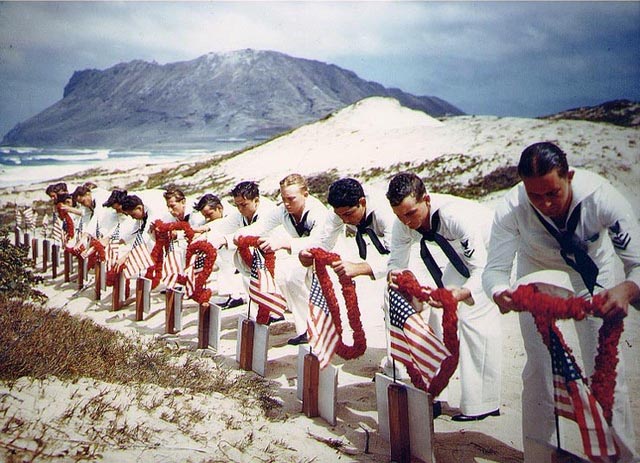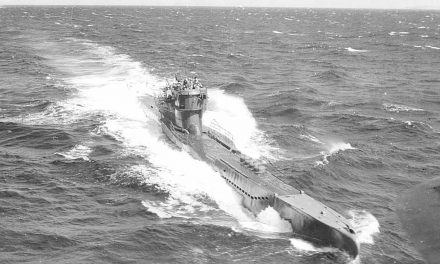The United States entered World War II only three months ago, but with one defeat after another, the outlook of this war seems bleak.
The American decision to join the fight was all but inevitable when the Japanese launched a surprise attack on Dec. 7, 1941, causing catastrophic damage to the naval base in Pearl Harbor. Although the U.S. had tried to stay out of the war, this was a deliberate and vicious attack on the country: its territory was bombed, over 1,000 sailors killed, ships and planes destroyed. The American people called for action – and for blood. Congress responded and declared war on Japan on Dec. 8. While this declaration showed Japan (and the rest of the world) that the U.S. is not afraid to step up and hit back, some are wondering if America was too swift to act. Was the U.S. ready to join the war? Are the Allied powers strong enough to win? Now, looking back at the few months that followed, and the countless battles lost to Japan and the Axis powers, the answer may be no – and the determination and optimism that make the U.S. great may be fading.
“We have been losing this war from the time we began it,” said Congressman Hatton W. Sumners (D, Tex.), “literally losing this war. We are being licked, and only the realization of the fact can arouse and solidify and vitalize the American people before it is too late.”

Sailors at Naval Air Station Kaneohe, on the island of Oahu, honor the men killed during the Pearl Harbor attack. After several heart-breaking defeats, Americans try to cling to hope. From Wikimedia Commons.
In mid-December, the Pacific island of Guam (which had been a U.S. possession) fell to the Japanese. Japan sent waves of planes to bomb the island, similar to the attack on Pearl Harbor, and successfully invaded on Dec. 10. With little U.S. military force on the island to fight back or defend the territory, it fell within hours, resulting in several U.S. casualties.
Around the same time, Japan attacked Wake and Midway islands, also U.S. possessions in the Pacific. After putting up a determined resistance, the vastly outnumbered American forces on Wake Island surrendered on Dec. 23; the detachment on Midway, better protected by the U.S. Navy, continues to hold out. The same cannot be said for the British possession of Singapore and the Dutch East Indies, both broken by the Japanese forces a few weeks ago. On Feb. 27 came another disastrous defeat for the U.S. and the Allied powers at the Battle of the Java Sea, where the Japanese struck the Allied naval force. Worse still for the Americans, it seems like only a matter of time before the U.S. territory of the Philippines must surrender.
While the German advance into the Soviet Union has slowed somewhat, the Axis Powers still control nearly all of continental Europe and have been pushing Allied forces out of North Africa.
Each of these battles on its own may not seem like such an important loss, but the string of loss after loss is significant, and a sign that this war may not end in a U.S. victory.
“Great, stupendous, terrible times like this come rarely in the history of the ages, in the history of civilizations,” said Congressman Sumners. “Such times come when nations and civilizations stand at the bar of judgement.”
Battles are not all the U.S. is losing—thousands of Americans have died and key warships have been destroyed or surrendered. The important U.S. battleship Lafayette was overturned; the U.S. destroyer Truxton and the Pollux cargo ship ran aground off the coast of Newfoundland, causing the deaths of 190 people.
The wartime economy has gone into overdrive, working hard to build the tools needed for this war. The Treasury spent $1.27 trillion on war materiel during the first weeks of February, and the number of ships scheduled to be built in 1942 is twice the amount built during World War I. Despite this effort, however, the U.S. is still struggling to build ships quickly enough to replace the ones that German submarines have been destroying. A shortage of shipping capacity may make it impossible to get desperately needed supplies to America’s British and Russian allies.
To many Americans, it may seem that Japan is always one step ahead – the attack on Pearl Harbor caught the U.S. off guard, and America has been unable to catch up ever since. The question that permeated the U.S. for years was whether it should enter the war at all; now the question has become, how can the U.S. win?
Yes, the Japanese deserve to pay for what happened at Pearl Harbor – and for what happened at Guam and Java Sea. However, as the victories keep piling up for Japan, it’s clear they are not being brought to justice. In fact, Japan and the Axis powers are winning this war.
U.S. morale may begin sinking, if it has not already; there have been few reasons for Americans to celebrate or feel inspired. What started out as an attempt to avenge Pearl Harbor has turned into a string of U.S. losses. However, this is the United States of America, and it would not be the country it is if there were not those Americans who remain determined and optimistic.
The unknown is a terrifying place, and unfortunately that is exactly where everyone is. Will the Axis powers continue winning? Will the U.S. finally overpower Japan and get the justice it desires? What is certain is that the U.S. will keep fighting, no matter the outcome.
As Congressman Sumners said: “The American people want to do this job. They have stuff in them.”
Sources:
Foe Believed Attempting Invasion Of Island: Tokyo Claims Three Of Our Destroyers, Cruiser Are Sunk, Others in Flight Thunderous Naval Battle Raging in Java Sea. (1942, February 28). The Washington Post, 1-2.
LOSS OF AMERICAN SHIPS. (1942, February 25). The Manchester Guardian, 5.
Musgrave, D. (1942, March 5). Remember Pearl Harbor. The Washington Post, 12.
We COULD Lose This War. (1942, March). Nation’s Business, 60-67.
Why the U.S. Can’t Fight. (1942, March 2). TIME, 39(9), 12.
Worst Week. (1942, February 23). TIME, 39(8), 15-17.






Thanks for checking out our site! You’re right, that could have been a good story too. There are so many interesting potential story topics, and one of our challenges is to narrow it down and decide which to pursue.
Observed your Blog on H-War. One look, does appear to be a worthwhile project. Looking forward to more of your efforts.
Coincident to this newsstory about Pearl Harbor and the attach from March 1942, another story you might consider is the mainland California reaction during these opening 3 1/2 months from December 41 to March-April ’42. :
“San Diego, California: First units of new volunteers joining the US Navy and other branches, have completed basic training and are being forwarded to Hawaii for the defense of Hawaii against any follow-on invasion of the Hawaiian Islands by Japanese military forces. The first units are departing to this potential forward area of this new World War in the Pacific. Reports indicate preparation to meet Japanese troops on the beaches and repel their advances towards the West Coast and California invasion in Hawaii. These Naval units and others will be among the first to fight and halt any attacks in Hawaii.”